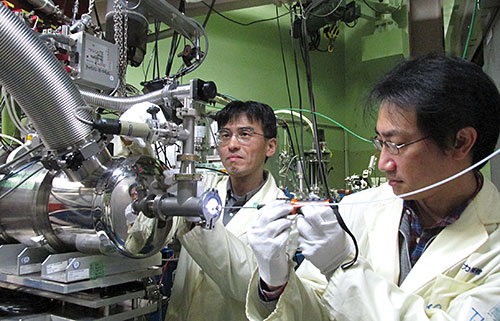Lawrencium’s ionization potential, atom by atom
DOI: 10.1063/PT.3.2802
The higher an element’s atomic number Z, the greater the effect of special relativity on its atomic structure. The innermost, speediest electrons are the most directly affected: Their relativistic mass causes their orbitals to contract, and the resulting change in nuclear charge screening alters the sizes and energies of all other electronic orbitals. The magnitude of the relativistic correction is small but noticeable in elements with Z as low as 30; it grows extremely rapidly in the heaviest elements, whose core electrons can exceed 75% of the speed of light.
The basic physics of the effect is well understood, but determining the consequences for large atoms poses a chicken-and-egg problem. Elements beyond fermium (Z = 100) can be made only one atom at a time. It’s possible to use laser spectroscopy to probe the energy levels of a single atom in a trap—but only if one already knows approximately where those energy levels lie. Theory is of limited help: Computational chemists have developed efficient methods for accurately calculating the electronic structures of molecules composed of small atoms, but figuring out how to adapt them into reliable methods for highly relativistic systems requires experimental benchmarks. As a result, not a single atomic energy level is confidently known for any element past Fm.
Now Yuichiro Nagame (Japan Atomic Energy Agency) and his colleagues have taken a step 1 toward filling that knowledge void by measuring the ionization potential—the energy required to remove the most weakly bound electron—of lawrencium (Z = 103). Standard methods for such a measurement use laser ionization and require a sample of 1010–1012 atoms. Nagame and colleagues devised a method 2 to do it with just a few thousand atoms produced one at a time over the course of several days.

Masato Asai (left) and Tetsuya Sato (right) prepare the apparatus for their ionization-potential measurement. The white tube Sato is holding delivers lawrencium atoms, contained in a carrier gas, to the tantalum ionizer inside the steel chamber.
TETSUYA K. SATO

The researchers produced 256Lr atoms by bombarding a californium-249 target with a beam of energetic boron-11 ions from the JAEA tandem accelerator in Tokai. Although 256Lr, with a half-life of 27 seconds, is far from Lr’s most stable isotope—some other isotopes have half-lives of hours—it’s one of the easiest to produce. And its half-life is perfectly adequate for the ionization experiment, which requires nuclei to survive for only a few seconds.
The JAEA researchers guided their Lr atoms into an ionization cavity, a hollow cylinder made of tantalum that they’d heated to 2700 K or higher. Some of the Lr atoms clung to the Ta surface and were ionized by the thermal energy. The researchers electrostatically extracted the newly formed ions from the cavity and counted them. The ion yield depends on Lr’s ionization potential, Ta’s work function, the temperature, and the experimental geometry. By accounting for all those factors, the team found the ionization potential to be 4.96 ± 0.08 eV.
That value agrees well with state-of-the-art theoretical calculations performed by Anastasia Borschevsky (Helmholtz Institute Mainz, Germany), a coauthor of the paper. Borschevsky used a form of coupled-cluster theory (see Physics Today, November 2013, page 15
Nagame and colleagues’ experimental error bars are a little too large to conclude that the coupled-cluster approach is definitely the right one. Fortunately, their main source of uncertainty is the counting statistics, so making a more precise measurement could be as straightforward as running a longer experiment. But beam time at the JAEA accelerator is a limited resource (see Physics Today, April 2015, page 18
Each of those elements has at least one sufficiently long-lived isotope that can be produced at a sufficiently high rate. And, importantly, all of their ionization potentials are expected to be below 6.5 eV, the highest that the researchers can hope to measure with their hot Ta cavity. Beyond rutherfordium, ionization potentials are expected to rise rapidly—peaking at 12 eV for copernicium (Z = 112), which would be far out of reach.
References
1. T. K. Sato et al., Nature 520, 209 (2015). https://doi.org/10.1038/nature14342
2. T. K. Sato et al., Rev. Sci. Instrum. 84, 023304 (2013). https://doi.org/10.1063/1.4789772
